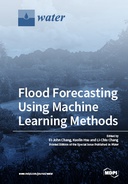Explore

Flood Forecasting Using Machine Learning Methods
Li-Chiu Chang, Kuolin Hsu, Fi-John Chang
28.0
0 Ungluers have
Faved this Work
Login to Fave
This book is a printed edition of the Special Issue Flood Forecasting Using Machine Learning Methods that was published in Water
This book is included in DOAB.
Why read this book? Have your say.
You must be logged in to comment.
Rights Information
Are you the author or publisher of this work? If so, you can claim it as yours by registering as an Unglue.it rights holder.Downloads
This work has been downloaded 481 times via unglue.it ebook links.
- 131 - pdf (CC BY-NC-ND) at Unglue.it.
- 303 - pdf (CC BY-NC-ND) at res.mdpi.com.
Keywords
- adaptive neuro-fuzzy inference system (ANFIS)
- ANFIS
- ANN
- ANN-based models
- artificial intelligence
- artificial neural network
- Artificial Neural Networks
- backtracking search optimization algorithm (BSA)
- bat algorithm
- bees algorithm
- big data
- classification and regression trees (CART)
- classification and regression trees (CART), data science
- convolutional neural networks
- cultural algorithm
- Data assimilation
- data forward prediction
- data scarce basins
- Data science
- Database
- decision tree
- deep learning
- Disasters
- Dongting Lake
- early flood warning systems
- empirical wavelet transform
- ensemble empirical mode decomposition (EEMD)
- ensemble machine learning
- ensemble technique
- extreme event management
- extreme learning machine (ELM)
- flash-flood
- flood events
- flood forecast
- flood forecasting
- flood inundation map
- flood prediction
- flood routing
- flood susceptibility modeling
- Forecasting
- Google Maps
- Haraz watershed
- high-resolution remote-sensing images
- hybrid &
- hybrid neural network
- hydrograph predictions
- hydroinformatics
- hydrologic model
- hydrologic models
- hydrometeorology
- improved bat algorithm
- invasive weed optimization
- Karahan flood
- lag analysis
- Lower Yellow River
- LSTM
- LSTM network
- Machine learning
- machine learning methods
- method of tracking energy differences (MTED)
- micro-model
- monthly streamflow forecasting
- Muskingum model
- natural hazards &
- natural hazards &
- nonlinear Muskingum model
- optimization
- Parameters
- particle filter algorithm
- particle swarm optimization
- phase space reconstruction
- postprocessing
- precipitation-runoff
- rainfall-runoff
- rainfall–runoff
- rainfall–runoff, hybrid &
- rainfall–runoff, hybrid &
- random forest
- rating curve method
- Real-time
- recurrent nonlinear autoregressive with exogenous inputs (RNARX)
- runoff series
- self-organizing map
- self-organizing map (SOM)
- sensitivity
- Soft computing
- St. Venant equations
- stopping criteria
- streamflow predictions
- superpixel
- support vector machine
- survey
- the Three Gorges Dam
- the upper Yangtze River
- time series prediction
- uncertainty
- urban water bodies
- water level forecast
- Wilson flood
- wolf pack algorithm
Links
DOI: 10.3390/books978-3-03897-549-6Editions


